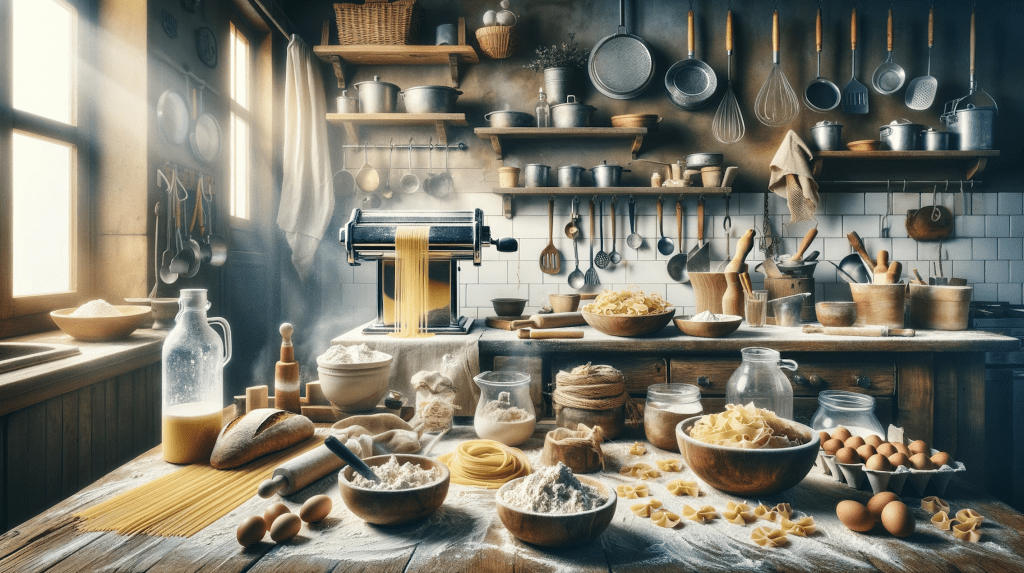At The Sourdough People, we cherish the art of sourdough baking and its endless culinary possibilities. In our quest to promote sustainable cooking practices, we’ve discovered a remarkable way to repurpose stale sourdough bread by transforming it into fresh, homemade pasta. This innovative zero-waste recipe not only helps reduce food waste but also introduces a delightful twist to traditional pasta dishes, making every bite a testament to the versatility and richness of sourdough.
Step-by-Step Recipe Guide
Creating fresh pasta from stale sourdough bread is a simple yet rewarding process.
Here’s how you can turn your leftover bread into a culinary delight:
- Dry the Bread: First, ensure that your stale sourdough bread is completely dried out. You can achieve this by leaving it in a warm part of your kitchen or utilizing the residual heat of your oven after cooking another dish. The goal is to remove all moisture, making the bread ready for grinding.
- Make Bread Flour: Once the bread is dry, break it into smaller pieces and blend it into fine flour using a blender or food processor. This step is crucial as it forms the base of your pasta dough.
- Mix Ingredients: In a mixing bowl, combine 100 grams of your freshly made bread flour with 100 grams of traditional pasta flour. Add in 2 large eggs or 100 grams of water, depending on your dietary preferences. Pulse and blend the mixture until it comes together into a cohesive ball. If the dough is too dry or too sticky, adjust the consistency by adding more flour or water as needed.
- Knead and Chill: Transfer the dough to a clean work surface and knead it for about five minutes until it becomes smooth and elastic. This step is essential for developing the gluten, which gives the pasta its texture. Once kneaded, wrap the dough in plastic wrap or place it in a container and let it chill in the refrigerator for at least 30 minutes. This resting period allows the dough to relax, making it easier to roll out later.
- Roll and Shape: After chilling, roll the dough into thin sheets using a pasta machine or a rolling pin. Aim for a uniform thickness to ensure even cooking. Once rolled out, cut the dough into your desired pasta shape, such as fettuccine, tagliatelle, or lasagne sheets.
- Cook: Bring a large pot of salted water to a rolling boil. Gently drop in the pasta and cook for about 2 minutes or until it floats to the surface. Fresh pasta cooks much quicker than dried pasta, so keep an eye on it to avoid overcooking.
Additional Thoughts
This sourdough pasta recipe is a beautiful example of how we can rethink our approach to food and cooking. By repurposing stale bread, we not only minimize waste but also create a flavorful and nutritious meal. Whether you’re a sourdough aficionado or a pasta enthusiast, this recipe is a must-try. Embrace the philosophy of zero-waste cooking with The Sourdough People and transform your kitchen into a sustainable and creative space.
More Pasta Options
- Bucatini: Thick, spaghetti-like pasta with a hole running through the center, ideal for rich tomato-based sauces.
- Cannelloni: Large cylindrical pasta for filling and baking, creating sumptuous, cheese-laden dishes.
- Capellini (Angel Hair): Create delicate Capellini for a light and elegant dish, best served with subtle oil-based sauces.
- Casarecce: Short, rolled pasta shapes that are perfect for capturing every kind of sauce.
- Chitarra: Square spaghetti traditionally made by pressing dough through a chitarra, great with all sauces.
- Conchiglie (Shells): Conchiglie’s concave shape is ideal for capturing bits of meat, vegetables, or cheese, creating a burst of flavor with each spoonful.
- Corzetti: Stamped pasta coins from Liguria, perfect for delicate sauces and pesto.
- Creste di Gallo: Crest-of-the-rooster shaped pasta that’s perfect for hearty and rustic sauces.
- Culurgiones: Sardinian stuffed pasta, resembling dumplings, filled with potato, cheese, and mint.
- Fagottini: Small pouches of pasta filled with cheese or vegetables, serving as a delightful bite-sized treat.
- Farfalle (Bow Ties): Farfalle, with its unique shape, is perfect for catching both light and creamy sauces.
- Fettuccine: Transform your stale sourdough bread into Fettuccine, perfect for soaking up rich, creamy sauces.
- Fiorelli: Flower-shaped pasta that can be stuffed with cheese or served with a simple sauce to highlight its shape.
- Fusilli: Fusilli’s twisted shape captures light and creamy sauces alike, offering a playful texture.
- Fusilli Bucati: Long, corkscrew-shaped pasta, perfect for catching every type of sauce in its grooves.
- Garganelli: Quill-shaped egg pasta that is excellent with ragu or cream-based sauces.
- Gemelli: Twinned pasta strands that are ideal for light and creamy sauces, offering a delightful bite.
- Gnocchi: Though traditionally potato-based, Gnocchi can also be attempted with sourdough bread flour for an inventive twist.
- Gragnano: Long, thick, tube-shaped pasta from the town of Gragnano, ideal for rich, meaty sauces.
- Lanterne: Named for its lantern shape, this pasta holds onto hearty sauces with its ridges.
- Lasagne: Use sourdough bread flour for Lasagne sheets to layer with cheese and sauce for a comforting baked dish.
- Linguine: Linguine made from sourdough bread flour pairs wonderfully with seafood or pesto sauces.
- Lumaconi: Large snail shell-shaped pasta, perfect for stuffing with cheese or spinach and ricotta.
- Mafaldine: Ribbon-shaped pasta with wavy edges, excellent for clinging to rich, chunky sauces.
- Malloreddus (Sardinian Gnocchi): Shell-shaped pasta that captures the essence of Sardinian cuisine, perfect with tomato sauce.
- Orzo: Small, rice-shaped pasta, perfect for soups or as a base in salad dishes.
- Orecchiette: Orecchiette, resembling little ears, are great for scooping up chunky sauces and veggies.
- Paccheri: Large tube pasta that can be stuffed with filling or served with chunky sauces.
- Pansotti: Triangle-shaped, stuffed pasta similar to ravioli, traditionally filled with a mix of greens and ricotta.
- Pappardelle: Pappardelle, with its broad, flat shape, becomes an exquisite canvas for chunky meat sauces.
- Penne: Penne’s tubular shape and angled ends are designed to hold hearty sauces, making it a versatile pasta choice.
- Pici: Hand-rolled, thick, long pasta similar to spaghetti, but with a chewier texture, perfect for rich sauces.
- Pizzoccheri: Short, flat, buckwheat noodles, traditionally served with cheese, potato, and greens.
- Quadrefiore: Four-leaf clover-shaped pasta that adds a playful touch to any pasta salad or light sauce dish.
- Radiatori: Resembling radiators, these are great for thick sauces and casseroles due to their unique shape.
- Ravioli: Craft Ravioli filled with your favorite combinations of cheese, meat, or vegetables for a versatile stuffed pasta.
- Ricciolini: Small, twisted pasta that works well in soups or with light, brothy sauces.
- Rigatoni: Rigatoni’s large tubes and ridges are perfect for thick, meaty sauces, ensuring a rich flavor in every bite.
- Rotelle: Wheel-shaped pasta that adds a fun element to any dish, especially appealing in pasta salads.
- Rotini: Rotini’s spirals are fantastic at gripping onto every drop of sauce, enhancing the flavor of each bite.
- Sagnarelli: Square-cut pasta with fluted edges, ideal for catching light to medium sauces.
- Scialatielli: Short, thick, hand-cut pasta from the Amalfi coast, perfect for seafood sauces.
- Sorprese: Surprise pasta with a hollow center, great for capturing small bits of sauce or cheese.
- Spaghetti: Spaghetti from sourdough bread offers a classic base for a variety of sauce pairings.
- Strozzapreti: “Priest-choker” pasta that is hand-rolled and twisted, excellent with pesto or light sauces.
- Tagliatelle: Use your sourdough bread flour to make Tagliatelle, ideal for clinging to hearty Bolognese.
- Tagliolini: Thin, ribbon-like pasta that works well with delicate seafood sauces.
- Torchio: Pasta shaped like a torch, great for catching and holding onto chunky sauces.
- Tortellini: Tortellini made from sourdough bread can be served in broth or with sauce, filled with savory cheese or meat.
- Trenette: Similar to linguine, this pasta is best served with traditional pesto and potatoes.
- Tripoline: Long, ribbon pasta with wavy edges on one side, perfect for thick sauces.
- Trofie: Short, twisted pasta that pairs wonderfully with pesto, especially Genovese pesto.
- Vermicelli: Thin, spaghetti-like pasta, excellent for light sauces or as a base in brothy soups.
- Ziti: Long, tube-shaped pasta that can be broken into shorter lengths, perfect for baked pasta dishes.





















